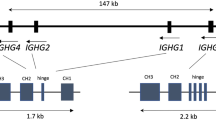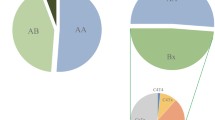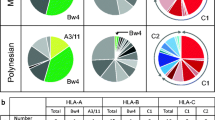Summary
Since the discovery in 1966 of the Gm ab3st gene, which characterizes Mongoloid populations, the distribution of allotypes of immunoglobulins (Gm) among Mongoloid populations scattered from Southeast Asia through East Asia to South America has been investigated, and the following conclusions can be drawn: 1. Mongoloid populations can be characterized by four Gm haplotypes, Gm ag, axg, ab3st, and afb1b3, and can be divided into two groups based on the analysis of genetic distances utilizing Gm haplotype frequency distributions: the first is a southern group characterized by a remarkably high frequency of Gm afb1b3 and a low frequency of Gm ag, and the second, a northern group characterized by a high frequency of both Gm ag and Gm ab3st but an extremely low frequency of Gm afb1b3. 2. Populations in China, mainly Han but including minority nationalities, show remarkable heterogeneity of Gm allotypes from north to south and contrast sharply to Korean and Japanese populations, which are considerably more homogenous with respect to these genetic markers. The center of dispersion of the Gm afb1b3 gene characterizing southern Mongoloids has been identified as the Guangxi and Yunnan area in the southwest of China. 3. The Gm ab3st gene, which is found with its the highest incidence among the northern Baikal Buriats, flows in all directions. However, this gene shows a precipitous drop from mainland China to Taiwan and Southeast Asia and from North to South America, although it is still found in high frequency among Eskimos, Koryaks, Yakuts, Tibetans, Olunchuns, Tungus, Koreans, Japanese, and Ainus. On the other hand, the gene was introduced into Huis, Uyghurs, Indians, Iranians, and spread as far as to include Hungarians and Sardinians in Italy. On the basis of these results, it is concluded that the Japanese race belongs to northern Mongoloids and that the origin of the Japanese race was in Siberia, and most likely in the Baikal area of the Soviet Union.
Similar content being viewed by others
References
Baker WC, McLaughlin PJ, Dayhoff MO (1972) Evolution of a complex system: the immunoglobulins. In: Dayhoff MO (ed) Atlas of protein sequence and structure. National Biochemical Research Foundation, Washington DC, pp 31–39
Cavalli-Sforza LL, Bodmer WF (1971) The genetics of human populations. Freeman, San Francisco
Deisenhofer J (1981) Crystallographic refinement and atomic models of a human Fc fragment and its complex with fragment B of protein A fromStaphylococcus aureus at 2.9- and 2.8- A resolution. Biochemistry 20:2361–2370
Grubb R, Laurell AB (1956) Hereditary serological human serum groups. Acta Pathol Microbiol Scand 39:390–398
Guttman L (1968) A general nonmetric technique for finding the smallest coordinate space for a configration of points. Psychometrika 33:469–506
Hirszfeld L, Hirszfeld H (1919) Serological differences between the blood of different races. The results of researches on the Macedonian front. Lancet II:675–679
Howells W (1973) The Pacific islanders. Weidenfeld & Nicolson, London
Ito S, Miyazaki T, Matsumoto H (1980) Interaction between normal human IgG3 carrying Gm (b1, b3), (g), (s,t) and protein A-Sepharose CL-4B. Proc Jpn Acad 56:226–231
Kronvall G, Williams RC (1969) Differences in anti-protein A activity among IgG subgroups. J Immunol 103:828–833
Loghem E van, Aalberse RC, Matsumoto H (1984) A genetic marker of human IgE heavy chain, Em(1). Vox Sang 46:195–206
Loghem E van, Tauszik T, Hollan S, Nijenhuis LE (1985) Immunoglobulin allotypes in Hungarian Gypsies. Relationship to population from India. J Immunogenet 12:131–137
Martensson L, Loghem E van, Matsumoto H, Nielsen J (1966) Gm(s) and Gm(t): genetic determinants of human ψ-globulin. Vox Sang 11:393–418
Matsumoto H (1984) On the origin of the Japanese race. Studies of genetic markers of the immunoglobulins. Proc Jpn Acad 60:211–216
Matsumoto H (1987) Characteristics of the Mongoloid and neighboring populations on the basis of the genetic markers of immunoglobulins (in Japanese). J Anthropol Soc Nippon 95:291–304
Matsumoto H, Miyazaki T (1972a) Gm and Km allotypes of the Ainu in Hidaka area, Hokkaido. Jpn J Hum Genet 17:20–26
Matsumoto H, Miyazaki T (1972b) Gm and Km allotypes of the Takasago tribes in Taiwan. Jpn J Hum Genet 17:27–37
Matsumoto H, Takatsuki K (1968) Gm factors in Japan: population and family studies. Jpn J Hum Genet 13:10–19
Matsumoto H, Miyazaki T, Lin JY, Hotta S (1975) The serum protein groups of Indonesians from Java. Jpn J Hum Genet 20:201–205
Matsumoto H, Toyomasu T, Sagisaka K, Takahashi K, Steinberg AG (1977) Studies of red cell and serum polymorphisms among the Matagi. Jpn J Hum Genet 23:271–280
Matsumoto H, Miyazaki T, Tamaki Y, Ohkura K, Miyashita T, Kang YS (1979a) Distribuion of Gm allotypes in the Korean populations. Jpn J Hum Genet 25:140
Matsumoto H, Miyazaki T, Omoto K, Misawa S, Harada S, Hirai M, Sumpaico JS, Medado PM, Ogonuki H (1979b) Population genetic studies of the Philippine Negritos. II. Gm and Km allotypes of three population groups. Am J Hum Genet 31:70–76
Matsumoto H, Miyazaki T, Ishida N, Katayama K (1982) Mongoloid populations from viewpoints of Gm patterns. Jpn J Hum Genet 27:272–282
Matsumoto H, Ito S, Miyazaki T, Ohta T (1983) Structural studies of a γ3 myeloma protein (Jir) bearing the allotypic markers Gm(s,t). J Immunol 131:1865–1870
Matsumoto H, Miyazaki T, Rychkov YG, Zhukova OV, Lebedeva IA, Kondik VM, Udina IG, Spitzin VA, Batsuur J, Shnader YV (1984) Studies on the human immunoglobulin allotypes in five populations in the USSR. Jpn J Hum Genet 29:105–111
Matsumoto H, Miyazaki T, Xu X, Watanabe H, Kawai N, Suzuki K (1986a) Distribution of Gm and Km allotypes among five populations in China. Am J Phys Anthropol 70:161–165
Matsumoto H, Ito S, Miyazaki T, Kawai N (1986b) Structural studies of another human IgG3 myeloma protein (Kam) carrying the allotypic markers Gm(s,t) and its alteration induced by chemical modification. In: Brinkmann B, Henningsen K (eds) Advances in forensic haemogenetics. Springer, Berlin Heidelberg New York, pp 153–156
Nei M (1972) Genetic distance between populations. Am Nat 106: 283–292
Osipova LP, Sukernik RI (1983) Immunoglobulin allotypes in aboriginal populations of the Taimir Peninsula. J Immunogenet 10:11–16
Sanders WT, Marino J (1970) New World prehistory. Archaeology of the American Indian. Prentice-Hall, Englewood Cliff, NJ
Shimizu A, Honzawa M, Ito S, Miyazaki T, Matsumoto H, Nakamura H, Michaelsen TE, Arata Y (1983) H NMR studies of the Fc region of human IgG1 and IgG3 immunoglobulins: assignment of histidine resonances in the CH3 domain and identification of IgG3 protein carrying G3m(s,t) allotypes. Mol Immunol 20:141–148
Steinberg AG, Cook CE (1981) Distribution of the human immunoglobulin allotypes. Oxford University Press, Oxford New York
Steinberg AG, Matsumoto H (1964) Studies on the Gm, Inv, Hp and Tf serum factors of Japanese population and families. Hum Biol 36:76–85
Takatsuki, K, Matsumoto H (1968) Human IgG globulin subclasses and Gm factors in Japanese (in Japanese). Saishin Igaku 23: 1578–1589
Turner MW (1976) Structural localization of human immunoglobulin allotypes. Biochem Soc Trans 4:29–32
Walter H, Matsumoto H, Miyazaki T, Mukherjee BN, Malhotra KC, Das BM, Gilbert K, Lindenberg P (1987) Distribution of Gm and Km allotypes among ten populations of Assam, India. Am J Phys Anthropol 73:439–445
Wright S (1951) The general structure of populations. Ann Eugen 15:322–351
Author information
Authors and Affiliations
Rights and permissions
About this article
Cite this article
Matsumoto, H. Characteristics of Mongoloid and neighboring populations based on the genetic markers of human immunoglobulins. Hum Genet 80, 207–218 (1988). https://doi.org/10.1007/BF01790088
Received:
Issue Date:
DOI: https://doi.org/10.1007/BF01790088




